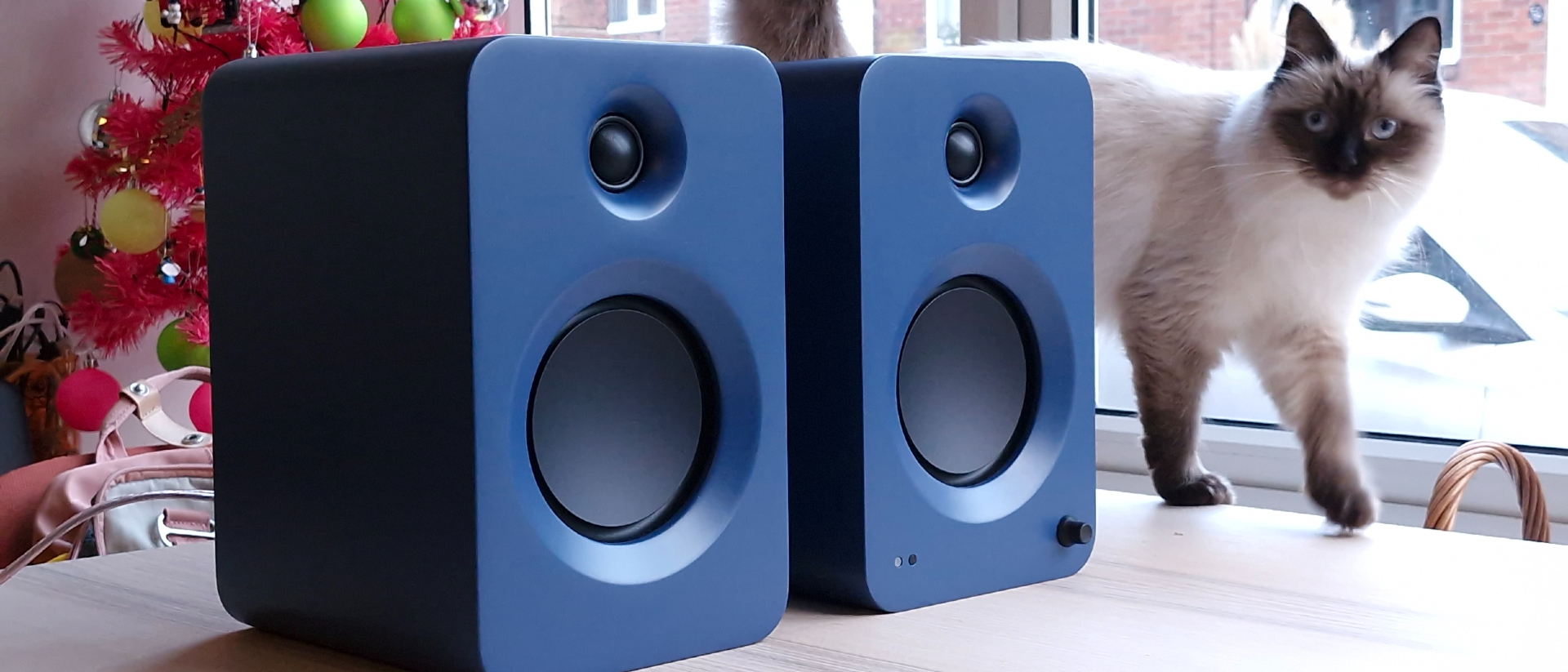TechRadar Verdict
When it comes to reviewing tech, particularly in audio and hi-fi spaces, it’s not common to find a product that ticks all the boxes with respect to a given reviewer’s criteria and instincts; there’s always some form of compromise, whether with build quality or a missed functionality trick. Sometimes, though, a brand will hit nail squarely on the head. And that is exactly what Kanto have done with their Ren speaker system. These powered stereo speakers are robust in build, rich in sound and refined in design – and they fit seamlessly into a wide variety of situations too. They’re an elegant iteration of integrated hi-fi, combining the form factor of studio reference monitors with the connectivity of a quality hi-fi amplifier separate. At any price, they’d beat any and every TV soundbar into a fine paste; at £599/€719 /$599, it’s barely even a competition.
Pros
- +
Tasteful-lookin’ modern speakers
- +
Incredible breadth of connectivity
- +
Huge, robust sound
Cons
- -
Vaguely unshapely bass response
- -
Matte finish can collect scuffs and fingerprints
- -
Remote control inputs sometimes slow
Why you can trust TechRadar
Kanto Ren: Two-minute review
The Kanto Ren powered speaker system is, basically, ace. Designed with multi-functionality in mind, Ren is a broad-strokes stereo hi-fi that can speak to most anything you’d want it to. With HDMI ARC, optical, USB-C, RCA and 3.5mm aux inputs, and with strong Bluetooth 5.3 connectivity besides, this is the does-everything bookshelf hi-fi system that most people spend a long time putting together piece by piece – and it sounds brilliant, as well.
These active speakers are relatively low-profile against similarly-powered hi-fi and AV systems, but pack a punch with their 100W RMS of auditory juice. There’s nothing lacking frequency-wise, with a rich and compelling responsiveness across the spectrum. This, coupled with its incredible dynamic response, makes it a supple system for TV and video games, as well as an impressive and convenient music delivery system.
In short, these are plug-and-play stereo speakers with quality internals and unbeatable I/O, and at quite a competitive price for its unique placement in the audio-tech market. The Kanto Ren should appeal to quite a few different people, whether you’re after a new bookshelf hi-fi, an alternative to a TV soundbar or a no-fuss all-in-one sound system. Some of the best stereo speakers we've tested in a while then? Why, yes.
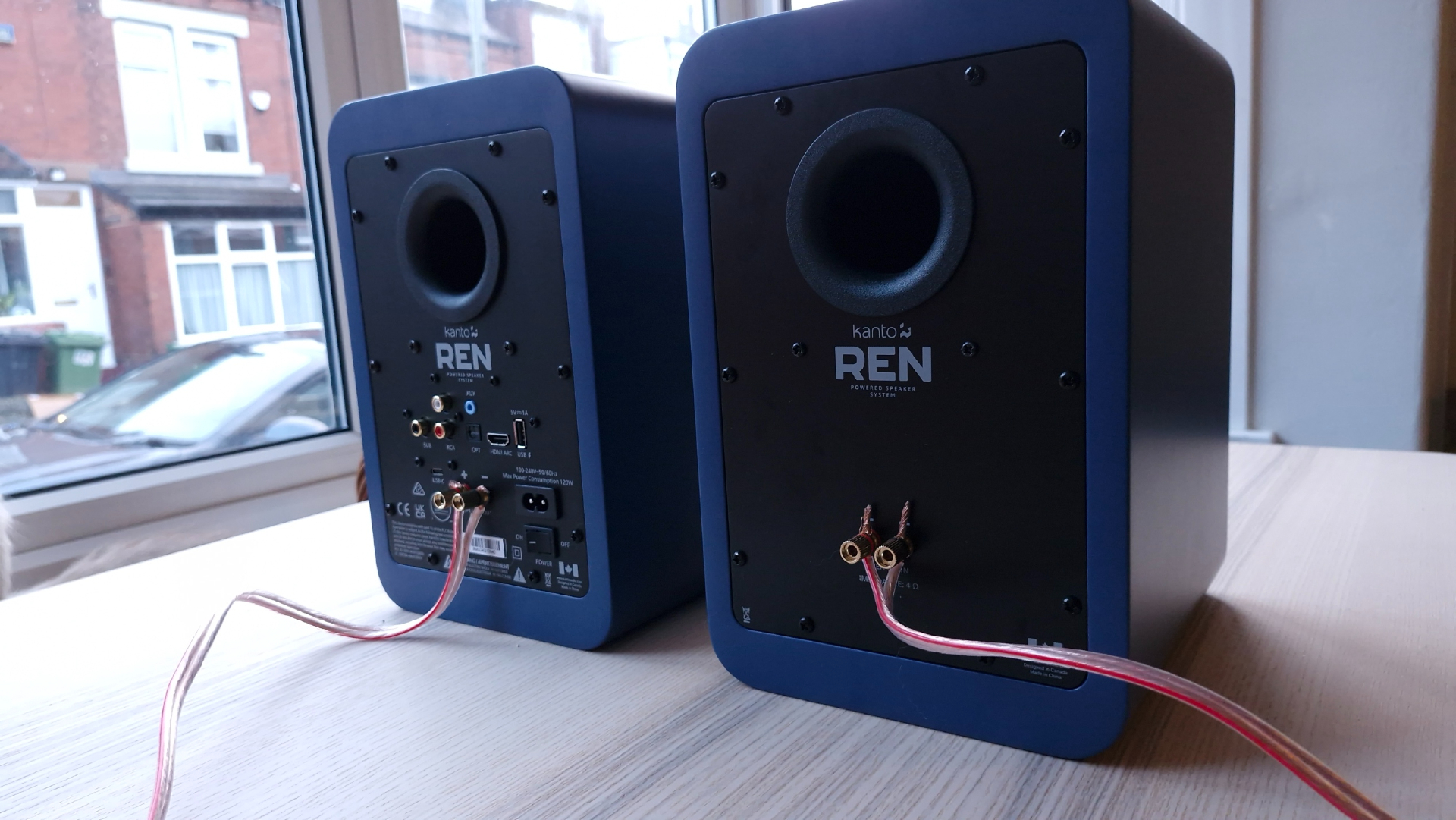
Kanto Ren review: Price & release date
- $599 / £599 / €719 (around AU$1,199)
- Launched on December 2nd
Most powered speakers of this ilk exist in the studio monitor space, as reference speakers for audio engineers and music producers – a few popular examples being Yamaha’s HS-series speakers and Adam Audio’s T5Vs (amongst a great many others we haven’t the time to profile here). These, though, are designed as practical utilities, and with music production specifically in mind – meaning fewer consumer-friendly inputs, and a frequency response curve that aims to be as flat and neutral as possible.
The Rens take the operating principles of these integrated desktop/studio solutions and brings them to the world of hi-fi, making for a genius marriage of smart audio-tech design and consumer need. In a market where customers are willing to spend upwards of four figures on a soundbar, this powerful and portable pair of highly-connectible modern bookshelf speakers is sure to stun.
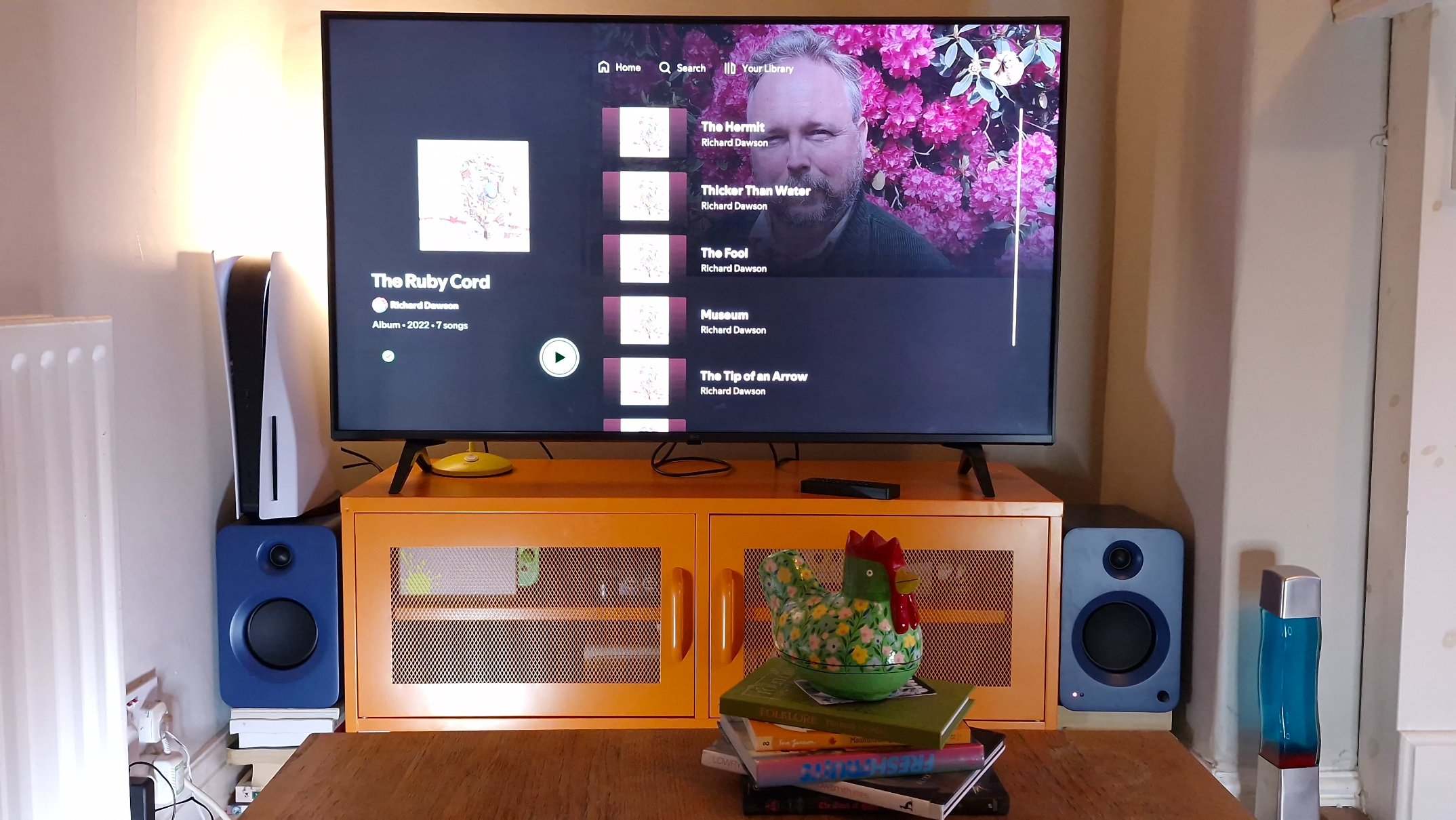
Kanto Ren review: Features
- Wide range of inputs – including USB-C and Bluetooth 5.3
- Optional subwoofer out for controlled bass
- 100W amplifier brings the juice
The Kanto Ren active speaker system is a well-featured all-in-one hi-fi dealio, cramming a powerful amp with some peerless connectivity into the chassis of one of the speakers. There’s six inputs to switch between here, including: USB-C, HDMI, optical, RCA, 3.5mm aux and Bluetooth 5.3. All of these are switch-between-able on the handy included remote control, which also gives you immediate control of bass, treble and volume levels (if you don’t feel like controlling any of the latter with the powered speaker’s front-borne rotary encoder, itself a satisfyingly tactile little knob).
The Kanto Ren is a stereo speaker system, and its integrated amplifier circuitry basically follows suit – which means no extending your setup to surround-sound (though why you’d ever want to do so with this particular setup is another question entirely). There is, however, an RCA subwoofer output – which naturally cries out to be paired with Kanto’s existing SUB8 sealed subwoofer. With a subwoofer plugged in, any sounds below 80Hz are neatly and automatically redirected to it; our review is a sub-less one, though, to focus on the merits of the Rens alone.
Inside, there’s some clever digital goings-on alongside the smart convenience displayed outside. There are two digital sound profiles you can engage and switch between – namely, the Vocal Boost and Night Mode algorithms, which respectively solve the two biggest problems facing the modern TV-binger: quiet dialogue and paper-thin party walls.
Another nifty digital feature is the Ren’s auto-wake function, which you can toggle on and off with the remote. This feature ensures the speakers leap to life the moment they detect incoming audio – meaning you can enjoy their enhanced sound soon as you switch your TV on. Everything’s geared to user convenience, and it shows; using the Kanto Ren system has been nothing but a breeze from day dot.
- Features score: 5/5
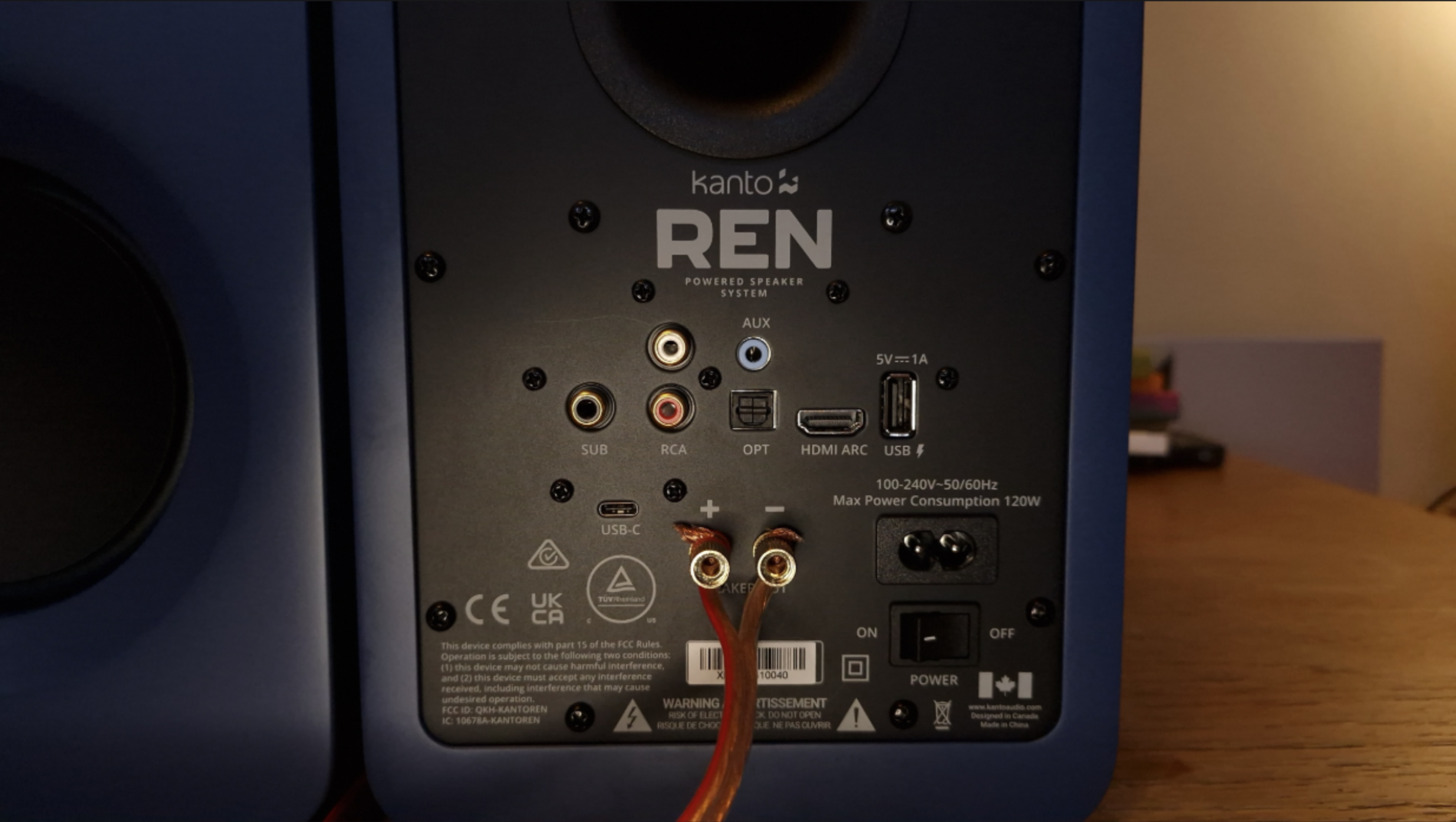
Kanto Ren review: Sound quality
- Simply: massive
- Incredible clarity of sound
- Slightly flabby low end
The Kanto Ren system was first put through its paces via its optical input, connected to my TV. My partner and I had picked an excellent time to rewatch the first two seasons of Twin Peaks together; Angelo Badalamenti’s intro theme was a hugely gratifying listen every time the opening credits swelled in, and every tense spook was robustly supported by the wellsprings of low end these speakers are capable of producing.
Speaking of spooks, the dynamic range of the Rens was thoroughly tested by my tremulous playthrough of mind-bending action-horror Alan Wake II on the PS5 – an excellent game whose subtle nods to the Twin Peaks mythos are more like vociferous headbangs. From subtle tension to outright jumpscares, the game’s sound design is a dynamic delight; the Rens handle every jolt and spike with great humour, even when in neighbour-placating ‘night mode’ setting.
The sonorous bass is supported in no small part by the ported rear, which supplies a lot of air movement – and, naturally, makes for a pumpy, slightly indistinct low-end. With this less-sculpted breathy ‘flab’ at higher volumes, you can see why Kanto went to the trouble of including a subwoofer output. Granted, my corner-alcove placement for TV listening won’t be winning any awards (and neither will my makeshift stacked-book speaker stands, for that matter), particularly with respect to bass response – which is why I tested them elsewhere in my house for their Bluetooth and aux-input musical merits.
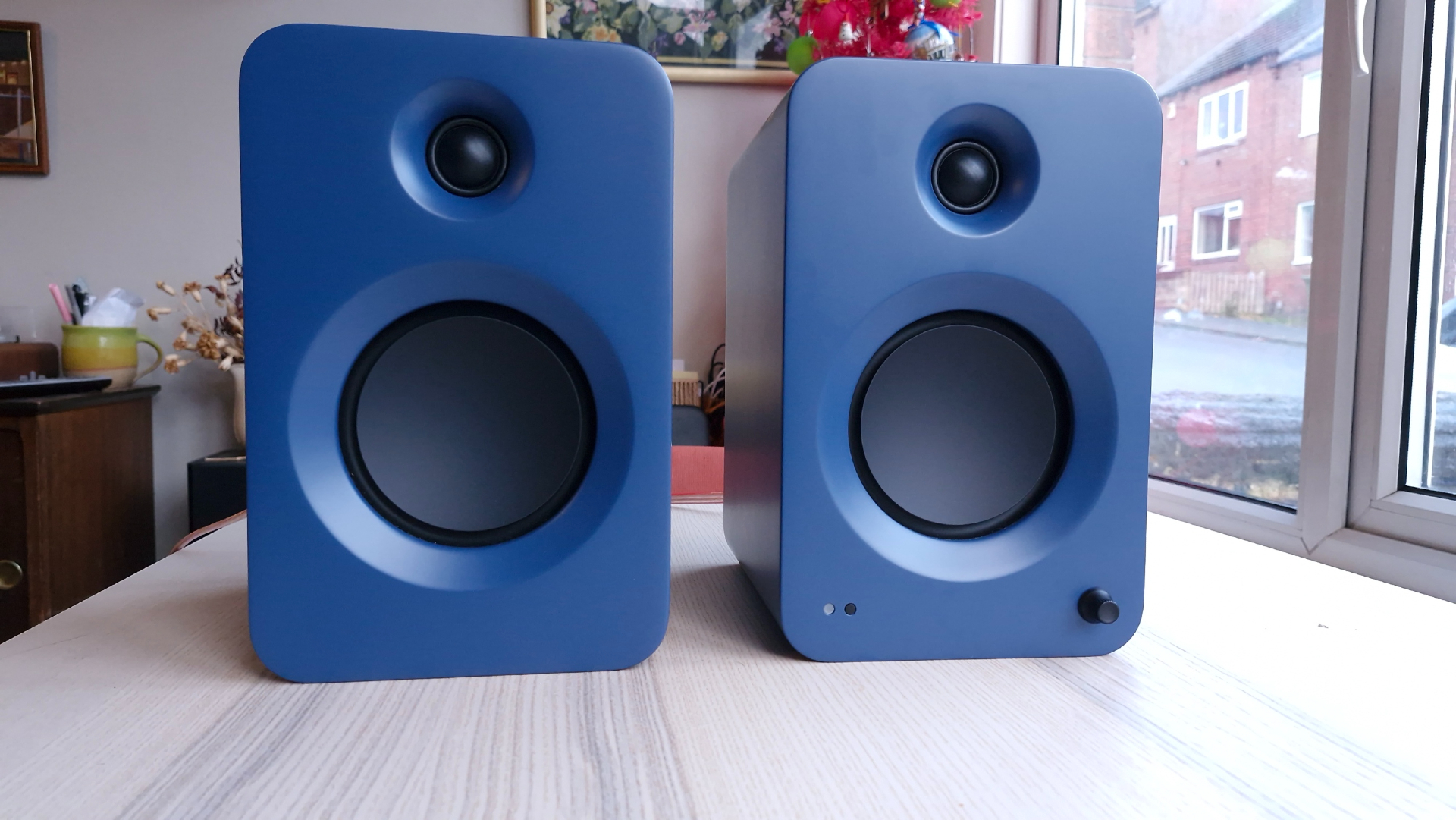
In testing out the Bluetooth mode, I whacked on Richard Dawson’s 2023 album The Hermit via Spotify – the title track of which is a 45-minute post-folk micro-odyssey through bucolic far-future Northumberland. This album-length song is extremely dynamically rich, and the Rens don’t falter for a moment in representing that richness.
Dawson’s croaked whispers vault into soaring leads, and tactile, distant electric guitars get swallowed by a Talk-Talk-y orchestra of loud-yet-ambient instrumentation; all of this is clear, distinct and well-separated, and as gratifyingly dynamic as the song could ever demand to be, all in spite of the potential throttling either Spotify or the Bluetooth codec can employ. Good work, Ren! That subtle breathiness in the bass is less pronounced without my bass-trappy alcove – but even within, the Rens still retained clarity and purposeful responsiveness practically everywhere else.
To test its handling of transients in a more controlled setting, I also listened to Cool Sounds’ Like That, an irreverent record full of groovy guitars and bright disco drums; Part-Time Punk’s gloriously dead 70s drums are tactile and three-dimensional, dance-y right-to-left tom fill revealing the strength of the Ren’s soundstage.
In all, the Kanto Ren stereo pair is a delightful-sounding array, and great in practically every scenario in which they could conceivably be placed. There are obvious shortcomings with respect to the ultra-low end, but shortcomings overcome by clever design – and which aren’t all that short of the mark to begin with. They’re loud, proud and unequivocally hi-fi, beating out a great many systems built for similar or even greater price-points. For this price, and with their place in the market borne firmly in mind, they’re practically perfect.
- Sound quality score: 5/5
Kanto Ren review: Design
- Beautiful – if delicate – matte finish
- Sleek front face
- A contemporary joy
The Kanto Ren speakers are, in a word, fetching. The MDF chassis combine considered contours with sleek surfaces; the flat front panel and its sharp vertices are offset by how beautifully the speaker cones are countersunk in – the dust covers of which are, themselves, delightfully suave.
This writer’s review set came in a fetching matte blue – but there are four other fetching matte colorways for you to pick from, including a fetchingly nostalgic orange. The slight disappointment of not getting the orange Rens to review was offset immediately by how tastefully – might I say, fetchingly? – the blue ones straddled our rather fetching orange TV stand.
The tasteful nature of the speakers extends to the soft LED dot on the active speaker unit – which smoothly changes hue depending on the audio sources you switch between. The optical source, which was used for the majority of this review, is represented by a shade of lilac I’d only describe as ‘kind’.
A small niggle, though, presents in how stubbornly finger-marks stick to that fetching matte finish. Despite the conclusions you may draw from the pictures supplied with this review, its writer’s hands are not grubby little mitts after all – but rather clumsy ones, the evidence of which is borne out by the near-unmovable streaks of dark across the otherwise-fetching front faces of the speakers. I digress.
As far as practical design is concerned, the Rens serve well. Threaded holes on the rear provide for those that might want to wall-mount their speakers, and rubber feet are provided separately so as not to rob you of choice in any matter. There are even some optional speaker grilles you can place over the front, held in place magnetically so as not to mar the sleek front with anchor slots. All told; the Kanto Ren system is designed beautifully, and considerately too.
- Design score: 4.5/5
Kanto Ren review: Setup and usability
- Pretty much plug-and-play
- Intuitive controls
- Could stand to ship with more cables
Being active speakers, setting up the Kanto Ren stereo set is an absolute trifle – the hardest part being the safe manoeuvring of the speakers into place without scuffing that fetching (I said it again!) matte finish. There’s no additional hi-fi amp-wrangling or cable-knotting to contend with, past the simple fact of connecting speaker to speaker, and audio source to system. Indeed, setting these up is about as simple as setting up any decent hi-fi system could ever be (and especially so for AV setups).
The remote control is the thing you’ll be interacting with the most by far, and it couldn’t be simpler to operate. Everything’s clearly signposted, and you barely need the remote control ‘map’ to know what you’re pressing. A minor point presents in the occasional unresponsiveness of the volume control to repeated presses, but a little patience goes a long way with smooth control of the Ren’s various parameters (as it of course does with life in general).
The speakers ship with a length of two-core speaker cable for you to connect left speaker with right, via the screw terminals at the rear. Unfortunately, the Rens don’t ship with additional HDMI or optical cables for comprehensive out-of-the-box connectivity; if you don’t already have the requisite cables to hand, you might be ordering in and waiting a day for what you need. This writer had – and most of you will have, at that – cables aplenty to hand, but a spare HDMI wouldn’t have gone amiss as a little out-of-the-box sweetener!
- Setup and usability score: 5/5
Kanto Ren review: Value
- Not an inconsiderable expense…
- But extremely well-priced for what you get
- Will knock the socks off most, if not all, soundbars
The $599/£599/€719 (so, around AU$1,199) price point is not a trifling one, even if it does technically fall towards the lower end of the price spectrum in a broader field of living-room sound-system solutions. It’s an investment for an integrated hi-fi system, whichever way you slice it – but it’s a great investment too, and in all the same slice-ings.
If you’re wanting a genuine upgrade from the soundbar you got last Black Friday which sounds ‘ok I guess’, you’ll be blown away by the difference these full-throated speakers provide. If you’re looking to invest in better sound for your TV for the first ever time – and looking for a foolproof plug-and-play place to start – you couldn’t spend $599 much better if you tried. Great-sounding integrated systems are hard to come by, but for me the Kanto Ren ticks all the right boxes. As a living-room stereo pair, these are perfectly pitched to handle everything – and pretty darn well, at that.
- Value score: 5/5
Should you buy the Kanto Ren?
| Attributes | Notes | Rating |
|---|---|---|
| Features | The Kanto Ren is a stacked stereo speaker system, with six different inputs – three digital, one optical and two analogue – for complete living-room versatility. Add in some extremely user-friendly digital flourishes, including a Night Mode and an auto-wake function, and baby, you’ve got a stew going on. | 5/5 |
| Sound quality | These Kanto Ren speakers sound phenomenal. They’re rich, full and clear, with tactile transient response and nifty dynamic handlings beside. The ultra-low end can get a tad pushy depending on your placement, but this is forgiven – particularly given how small these speakers are against just how much they can provide. | 5/5 |
| Design | I mean, look at them. A great matte finish with five striking colourways – the best of which is undeniably the orange (and which I’m certainly not a tiny bit upset about not receiving for review). The chassis are cleanly designed a genuine joy to behold as part of one’s home – and even the LED is pretty! | 4.5/5 |
| Value | Absolutely an investment, whichever way you cut it – but when inferior-sounding soundbar systems are double the price, investing in the Kanto Ren becomes a bit of a no-brainer. Great price for a great-looking set of speakers with a great sound! | 5/5 |
Buy them if...
You want excellent hi-fi sound without the faff
The Kanto Ren system packs a shedload of functionality into the form of two mid-sized bookshelf speakers. You don’t need anything else to guarantee a quality listening or watching experience – save for a decent subwoofer to tack on if you’ve a larger space to serve. With its broad connectivity, it can be your everything-system for anything – whether you connect your laptop via USB-C, your Wi-Fi streaming set-up via optical, or your TV via HDMI.
You’re thinking about buying a soundbar
Yes, soundbars are pretty nifty looking, and yes, some soundbars purport to do pseudo-surround sound really well, but all soundbars are undeniably limited by their form. The Kanto Ren brings controlled richness and huge dynamic range in an unconventional iteration of a conventional hi-fi format, and will resultingly blow any and all consumer-grade soundbars out of the water with consummate ease.
Don't buy them if...
You want a surround-sound AV setup
Being an active stereo speaker array, it should not come as a surprise that the Kanto Ren’s integrated amplifier is stereo through and through, and does not have an additional 3 channels for surround sound. Still, if you’re wanting something that’s more expressly home-cinema-coded, maybe give these a miss.
You value upgradeability
The Kanto Ren is an integrated stereo amplifier system, with all the bells and whistles built right into the speakers themselves. If you like the idea of trying out some new speakers in the future, or eventually investing in some audiophile-grade tube amplifier system, you should be spending your money on a more modular type of hi-fi system.
Kanto Ren: Also consider
Klipsch R-51PM
Klipsch is another vaunted name in hi-fi, on account of the incredible dynamics their speakers are capable of representing (amongst other things). These are an active bookshelf offering, with optical, USB and RCA in amongst other I/O opportunities. There’s no HDMI ARC here, but there is an incredible soundstage – and a built-in phono pre-amp for the budding vinyl enthusiasts in the room.
Read more in our full Klipsch R-51PM review
KEF LSX II
KEF’s LSXII stereo speakers are similarly impressive in terms of connectivity, with HMDI ARC, optical and USB-C as well as KEF’s own W2 streaming architecture. The cones are a little smaller, and the price a little higher – but there’s some signature KEF quality in these tiny bookshelf powerhouses.
How I tested the Kanto Ren
- Tested for 4 weeks
- Used primarily in living room, as main system for TV and for audio streaming.
- Briefly tested in other regions of the home as an auxiliary hi-fi system (and to ensure verdicts weren’t skewed by the sound profile of my living room alcove).
The Kanto Ren speakers spent most of their time bookending my TV in the inner alcove of my living room, where they were put to the test, via HDMI ARC and optical input, as the primary audio system for watching TV and playing video games – as well as, in hi-fi terms, for Bluetooth streaming. Phono and Bluetooth were also trialled in my attic office, in order to assess the frequency response of the speakers in different acoustic spaces. I listened to personal-favourite records, the sound of which I could comfortably corroborate against the performance of other systems with which I’m familiar.
First reviewed: December 2024
Read more about how we test at TechRadar

James Grimshaw is a freelance writer and music obsessive with over a decade in music, audio and tech writing. They’ve lent their audio-tech opinions (amongst others) to the likes of Musicradar, Louder, Guitar.com and the London Evening Standard – before which, they interviewed indie glitterati for online music publications a-many. When they aren’t blasting esoteric music around the house, they’re playing out with esoteric artists in DIY spaces across the country; James will evangelise to you about obscure late-2000s records until the sun comes up.
